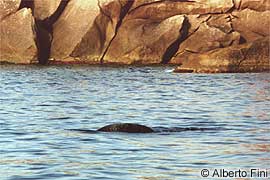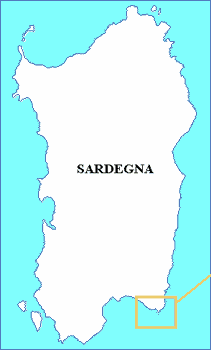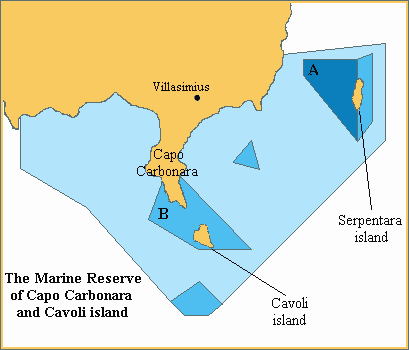Albania / Bulgaria / Croatia / Greece / Italy / Madeira / Mauritania & Western Sahara / Turkey
Italy
Sighting spurs government action
"It was 8.30 am and we were on our boat, 30-40 metres from Cavoli Island, when we heard something moving and a noise like a dolphin. We looked and we saw the face of the seal swimming from right to left. She dove down and reappeared 3 or 4 times, and I made the picture while she was going down! Unfortunately, it was exposure number 27 on my roll of film – in other words the very last one!!"
– Dr. Alberto Fini. |
 |
On 22 August 2000, a Mediterranean monk seal was observed in the Marine Reserve of Capo Carbonara e l'Isola dei Cavoli, on the southeastern coast of Sardinia. Following the sighting, the mayor of the Reserve's nearby town, Villasimius, and its management body, contacted the Italian Ministry of the Environment and ICRAM, requesting that the details of the sighting be verified and priority actions be identified.
The Marine Reserve (MR) of Capo Carbonara was established in 1999 and the monk seal sighting occurred in its Zone B, where tourist presence is permitted but fishing prohibited except for the use of artisanal set nets by local inhabitants (there are only 7 licenses for this type of fishing). The monk seal was sighted and photographed at approximately 8:30 am, 20 metres east of the Eastern Faraglione of Cavoli island (Figure 1) by a summer resident of the area (see Alberto Fini's account, above). The monk seal was seen swimming on the surface in a stretch of sea with an average depth of 25 metres, and was identified as a seal due to its round head and eyes and the presence of vibrissae. Dr. Fini was interviewed and the photograph and its negative analyzed to determine its authenticity. The photograph is the 26-27th exposure on a film of 24 exposures. According to Dr. Fini’s account and the photograph, the animal appears to have been approximately 2 metres in length. The back of the animal was dark grey to black, with a noticeable quantity of lighter scars in the anterior section. Although the head is not visible, as the animal was in the process of diving at the moment of the photograph being taken, part of the tail and the top portion of the rear flippers is noticeable to the right of the body.
 
Fig. 1: Map of Sardinia and details of the Marine Reserve area of Capo Carbonara
The sighting of a monk seal is not altogether an extraordinary event in Sardinia considering that there are at least 25 locations known historically to have been inhabited by monk seals. In the past, monk seals were observed on the southeastern coast of Sardinia in locations such as Capo S. Elia in Cagliari, the islands of Cavoli and Serpentara and in Cala Pira (Valdes e Ebau 1996). This presence is confirmed by the accounts of local fishermen in Villasimius, who were interviewed on site on August 30th 2000 (see Table 2). Monk seal sightings have been recorded over the last two decades along the Italian coasts of Sardinia and the lesser Sicilian islands (see Table 3). The origin of these animals has always been attributed to vagrant individuals originating from Tunisia and Algeria. However, the persistent occurrence of sightings, despite the high degree of human encroachment along Italian coasts, suggests that one or more individuals may still be present for brief or longer periods of time in certain areas, and it is possible that such individuals spend their time transiting between Italy and the nearby Tunisian coasts. Given the proximity of the Tunisian coasts to Sardinia and the smaller Sicilian islands, it may be possible that a small population of animals still exists in a distribution range encompassing these locations. Such a hypothesis is feasible considering the recent information on the species' capacity of wide-ranging movements (Adamantopolou et al. 1999, Gazo 1998).
Activities carried out following the sighting event
Within 48 hours of the sighting, a rapid evaluation of the event prompted a series of actions to be undertaken:
1. Official request by the Reserve’s management body to reduce human activity around the island of Cavoli, including:
- A temporary moratorium on all the commercial diving activities and tourist tours within a 200 metre belt surrounding Cavoli, from 25/08/2000.
- All anchoring and transit of recreational boats to take place outside the 200 metre belt of Cavoli island.
- A reduction in boat speed from 10 to 5 knots in zone B of the Reserve.
The moratorium on commercial diving activities and tours was respected immediately by the local agencies and maintained for 10 days, after which diving activity in the area was gradually resumed due to the absence of further recorded sightings. Despite the distribution of a flyer explaining the reasons for a temporary moratorium on navigation in the area, anchoring and transit of recreational boats still took place for several days following the sighting event. Several days of control and public reminders were required in order for the general public to respect the management body's request. Given the high tourist presence along the coast, the moratorium was purposefully proposed without the aid of a legally binding instrument in order to avoid unnecessary public protests and retaliation against the management body's requests. The diminishing tourist presence in Zone B from 28 August onwards coincided both with the end of the holiday season and combined public awareness efforts. The difficulties encountered in soliciting a favourable response from the general public to the management body’s request are a clear reminder of the environmental awareness efforts that need to be exerted in high-tourism impact areas of the Mediterranean.
On the basis of available evidence, it must be concluded that the presence of one or more monk seal individuals along the southeastern coast of Sardinia during the month of August is very likely. It is also possible that the individual sighted on 20/08/00 in the area of the Gulf of Orosei is different from that sighted in the MR of Capo Carbonara. The repeated sightings of an animal in the MR's waters for a period of several weeks highlight the need to monitor the area on a longer term basis.
On October 13th the Steering Committee of the MR of Capo Carbonara decided to adopt the following priority actions for the following year. The activities will be conducted with the technical and scientific support of ICRAM.
- Personnel involved in surveillance activities of the MR will include in its daily patrol duties, observation sessions from selected lookout points, and patrol routes at sea so as to enhance the probability of recording any possible monk seal presence.
- Identification, mapping and photographing of areas of coastline suitable as monk seal haul-out sites both within the MR and adjacent coasts.
- Development and application of a non-invasive method of monitoring monk seal use of inventoried haul-out sites.
- Development of a marine environmental awareness campaign directed at the students of the middle school of Villasimius.
- Development and implementation of a survey to collect monk seal sightings data directed at the local fishing communities of southern Sardinia.
Based on the results of these activities, attention will then focus on assessing the need to modify existing regulation of human activities within the MR. – Giulia Mo, Protected Species Framework Programme, ICRAM, Rome
|
Table 1
Recent sightings of monk seals in southern Sardinia.
|
|
Date
|
Hour
|
Location
|
N. animals
|
Comment
|
|
01.08.2000
|
am
|
Area southwest of the MR
|
2
|
The sighting was verbally reported to the National Coast Guard personnel on duty in the area but details of the event and the observers were not recorded, precluding a later interview. However, as the event was reported prior to the photographed sighting of 22/08 it is likely that it was reported in good faith. |
|
15.08.2000
|
7:00
|
South-eastern coast of the MR
|
1
|
The sighting was verbally reported to the National Forestry Division on duty in the area but details of the event and the observers were not recorded, precluding a later interview. However, as the event was reported prior to the photographed sighting of 22/08 it is likely that it was reported in good faith. |
|
18.08.2000
|
7:00
|
Area southwest of the MR; approx. 1 mile off coast
|
1
|
The information and the details gathered during the interview of the observer seem very feasible and there is reason to believe that it entails an authentic sighting of a Mediterranean monk seal. However, there is no photographed documentation. |
|
20.08.2000
|
15:30
|
Southern area of the Golfo di Orosei; 2 miles off shore
|
1
|
Information gathered during the interview with the observer appears reliable and there is reason to believe that this was an authentic sighting, although the distance of the Golfo di Orosei from the area of sightings in the MR suggests that the sightings may involve different individuals. There is no photographic evidence. |
|
22.08.2000
|
8:30
|
Island of Cavoli, RM
|
1
|
The sighting is confirmed; there is photographic documentation. |
|
22.08.2000
|
19:20
|
Golfo degli Angeli, southeastern Sardinia
|
1
|
The observer seems reliable and there is reason to believe that this entails an authentic sighting of a Mediterranean monk seal. However, there is no photographic evidence. |
|
23.08.2000
|
8:00
|
Island of Cavoli, RM
|
1
|
The observer is very credible but the visibility is poor and the reported sighting does not have sufficient information. |
|
23.08.2000
|
11:30
|
Island of Cavoli, MR
|
1
|
The observer's report appears to be in good faith, but there is little data and it is possible that he may have mistaken a diver for a seal. |
|
26.08.2000
|
18:30
|
Northern area of the MR
|
1
|
There is insufficient information on the reported sighting and it is difficult to express a judgement of credibility with regard to the event. |
Table 2
Data on the historical presence of monk seals along the coasts of the MR of Capo Carbonara and adjacent areas resulting from interviews of local fishermen conducted on 30/08/2000.
|
|
Est. age of fishermen
|
Area with reported seal presence
|
When
|
|
65-70
|
- Sartoru, Villaputzu (north of the MR)
- Scogli di Piscaddeddus, MR
- Punta Porceddus, MR
|
1970s
|
| Recorded observations and conclusions |
At Villaputzu, a coral fisherman, captured a seal in a lobster trap.
Conclusion: The Mediterranean monk seal was present well into the area north of Capo Carbonara and this stretch of coast must therefore have suitable habitat required by the species.
Animals were observed during almost all months of the year hauled out on the small islets of Piscaddeddus, in the southwestern portion of the MR and these animals were thought to be responsible for net damage. The animals that were observed were dark and were often heard vocalizing. Their fur was uniformly dark and had no lighter patches. Every so often the animals were observed hauling out at night on the beaches close to the islets. The individuals were not very long and were quite slender (average length reported, 1.2-1.5 m).
Every so often individuals were observed hauled out on the rocks of Punta Proceddus, on the northern coastline of the MR.
Conclusion: Young individuals must have been present throughout the year in various areas of the MR.
|
|
Est. age of fishermen
|
Area with reported seal presence
|
When
|
60-65
60-65
55-60
|
- Rocks of Ommini Morti and of the island of Serpentara, MR
- Small inlets of the Cavoli island
- Punta Molentis and the "Secca dei Berni", MR
|
1960-70s
|
| Recorded observations and conclusions |
Seals were observed sleeping on the rocks of Punta Ommini Morti and it was said that there was a cave on the island of Serpentara where the animals rested.
Some animals, according to the fishermen, were capable of recognising the sound of the motor engines of the fishing boats and they would follow the boats when the fishing nets were hauled up on deck, because the fishermen would throw unwanted fish at the seals for them to eat. Young animals were lighter in colour and were more frequently seen in the spring. Females were smaller than males (1.5-2 m in length) and had darker marks on their bodies. The males were bigger and had noticeably lighter fur on their snout, chin and neck area. Their length probably exceeded 3 metres.
Conclusion: Adult males and females were present in the MR and were probably reproductively active in this area, utilising coastal areas of the MR. It is possible that there are caves and other suitable habitat characteristics for the species.
|
|
Est. age of fishermen
|
Area with reported seal presence
|
When
|
|
65
|
|
1960s
|
| Recorded observations and conclusions |
3-4 individuals inhabited Capo Teulada and the fishermen sometimes used dynamite to scare away the seals when the nets were hauled out on deck; otherwise the seals would eat the fish from the nets. The use of dynamite was apparently practiced in the area of Capo Carbonara as well.
Conclusion: Monk seals were present in other areas of southern Sardinia and the use of illegal fishing practices with explosives was probably a disturbance and threat factor for the seals in the 1960s.
|
Table 3
Reports of animal sightings or individuals reported dead at various locations in Tunisia, Italy and proximate areas.
|
| |
TUNISIA
|
ITALY & other areas
|
|
La Galite
|
Zembra
|
Location
|
|
Year
|
|
|
|
|
1965
|
|
2 ind. killed
|
Nucleus present in Golfo di Orosei (E Sardinia)
|
|
1966
|
|
|
" |
|
1967
|
|
|
" |
|
1968
|
|
|
" |
|
1969
|
|
|
" |
|
1970
|
Approx. 20 ind.
|
1 killed, 1 observed
|
" |
|
1971
|
|
|
" |
|
1972
|
|
|
" |
|
1973
|
|
1 observed
3 ind. at Sousse
|
" |
|
1974
|
2 Gal. Est
|
|
"
+ 1 ind. seen in Malta |
|
1975
|
|
|
Last individual killed in Marettimo
|
|
1976
|
|
2 killed, 2 observed
|
Population diminishing in Golfo di Orosei
|
|
1977
|
1 observed
|
1 killed, 2 observed (estimate 3-4 ind.)
|
" |
|
1978
|
6-8 individuals
|
|
" |
|
1979
|
|
|
" |
|
1980
|
|
|
1 sighting Lampedusa
|
|
1981
|
|
|
|
|
1982
|
|
|
|
|
1983
|
|
|
|
|
1984
|
1 ind. 110 km NE
|
|
|
|
1985
|
|
|
No seals in Orosei caves but sightings in NE, E, and SW Sardinia
|
|
1986
|
2-3 individuals
|
|
Last birth recorded in Sardinia (NW coast)
|
|
1987
|
Data missing
|
Data missing
|
Various sightings at NE, E and SW Sardinia
|
|
1988
|
"
|
"
|
2 sightings NE Sardinia and 1 on E Sardinia
|
|
1989
|
"
|
"
|
3 sightings E Sardinia
|
|
1990
|
"
|
"
|
1 sighting Corsica
|
|
1991
|
"
|
"
|
|
|
1992
|
"
|
"
|
1 sighting NE Sardinia, 1 E Sardinia
|
|
1993
|
"
|
"
|
|
|
1994
|
"
|
"
|
|
|
1995
|
"
|
"
|
1 SW Sardinia; 1 NE Sardinia
|
|
1996
|
"
|
"
|
1 NE Sardinia
|
|
1997
|
"
|
"
|
1 SW Sardinia
|
|
1998
|
"
|
"
|
1 SW Sicily, 1 Pantelleria, 1 12nm NW Malta
|
|
2000
|
"
|
"
|
1 documented sighting and various undocumented in the MR of Capo Carbonara and nearby areas (SE Sardinia)
1 sighting E Sardinia
1 sighting E Puglia (SE tip of Italy)
|
Sources
Adamantopolou, S., E. Androukaki, P. Dendrinos, E. Tounta, S. Kotomatas. 1999. Evidence on the movement of the Mediterranean monk seal Monachus monachus in Greece. Abstracts. 13th Biennial Conference on the Biology of Marine Mammals, Wailea, Hawaii: 2.
Gazo M. 1998. Diving activity data of one of the most endangered divers: a Mediterranean monk seal adult male. How to obtain the information without disturbing the diver. European Research on Cetaceans. Vol.11. Proceedings of the Eleventh Annual Conference of the European Cetacean Society.
Valdes P. & E. Ebau. 1996. La Foca monaca in Sardegna: uno studio inedito. Sardegna Speleologica, n.10, Dicembre. |




